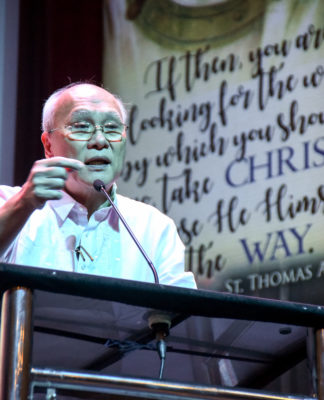A YOUTH partylist group seeking reelection in the May polls has hit UST and five other private universities for “almost doubling” their profits and tuition collections over the past five years of tuition increases.
In a forum on tuition and other school fees convened by the House of Representatives’ Committee on Higher and Technical Education last Feb. 3, outgoing Kabataan Partylist Rep. Terry Ridon and first nominee Sarah Elago presented a report on the finances of six universities using data from the Securities and Exchange Commission (SEC).
Data presented in the House forum however showed that not all of the universities doubled their tuition collections and net profits or net revenues.
Ridon said three universities that are stock corporations hiked their net profits as follows:
Far Eastern University, 81 percent growth, to P1.08 billion in 2015 from P713 million in 2010; Lyceum of the Philippines, more than 140 percent growth, to P657.6 million in 2015 from P272.6 million in 2010; and University of the East, 30 percent growth, to P463.5 million in 2015 from P352.3 million in 2010.
Two non-stock, nonprofit universities also saw higher net revenues or total collections less operating expenses, he said: De La Salle University, 62 percent growth in net revenue, to P734 million in 2015 from P381.9 million in 2010; and the University of Santo Tomas, 38 percent growth, to P1.3 billion in 2015 from P941 million in 2010.
The Varsitarian tried but failed to get comments from the UST Office for Student Affairs and the UST Central Student Council.
For this academic year, UST cut its tuition hike to 2.5 to 5.3 percent from 5 to 8 percent after a consultation with student leaders.
Tuition collection
The left-leaning Kabataan Partylist group also presented data on tuition and fee collections over a five-year period, citing SEC data:
UST, more than 40 percent growth, to P4.1 billion in 2015 from P2.9 billion in 2010, or “an increase of over P27,000 in the annual matriculation rates of a UST student in just five years, with the average tuition and other school fees in the said school ballooning from P68,000 in 2010 to over P95,000 in 2015”; La Salle, 62 percent growth, to P2.9 billion in 2015 from P1.8 billion in 2010, which “raise[d] the average annual matriculation in the said university from P93,000 in 2010 to over P151,000 in 2015”; and Ateneo de Manila, 43 percent growth, to P2.7 billion in 2015 from P1.9 billion in 2010, with average annual matriculation increasing “from P187,000 in 2010 to P266,000 in 2015.”
State universities also hiked their tuition collections, the group said, noting that state universities, while enjoying taxpayer subsidies, are required by the government to be “self-sustaining.”
Tuition collections in state universities and colleges went up by 55 percent to P8.1 billion in 2015 from P5.3 billion in 2010, the group said, citing data from the Department of Budget and Management.
The University of the Philippines alone increased tuition collection to P473 million in 2014 from P355 million in 2010, the group said.
Ridon said 400 colleges and universities were planning to increase tuition for academic year 2016-2017. Elago called for a “radical reorientation of our education policy,” claiming that tuition hikes have “eroded and snatched the youth’s fundamental right to education.”
Under Section 42 of Batas Pambansa Blg. 232 or the Education Act of 1982, “Each private school shall determine its rate of tuition and other school fees or charges… subject to rules and regulations promulgated…”
By law, 70 percent of tuition increases must go to salaries, wages, allowances, and other benefits of teaching and non-teaching personnel; and 20 percent to the improvement or modernization of buildings, equipment, libraries, laboratories, and similar facilities, and payment for other operational costs. The remaining 10 percent represents return on investments for higher education institutions if they are stock corporations. Otherwise, it must be used for operations.
The Commission on Higher Education uses inflation—the rate of increase in prices of consumer goods and services as measured by the consumer price index—as a guide for regulating tuition hikes. Inflation averaged 4.1 percent in 2014 and 1.4 percent in 2015, according to data from the Philippine Statistics Authority.
















